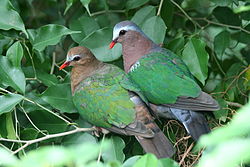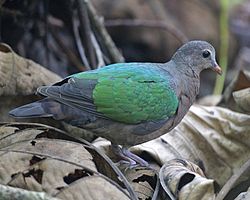Common emerald dove
| Common emerald dove | |
|---|---|

| |
| Scientific classification | |
| : | [[Template:Taxonomy/Chalcophaps]] |
| Species: | Template:Taxonomy/ChalcophapsC. indica
|
| Binomial name | |
| Template:Taxonomy/ChalcophapsChalcophaps indica | |
| Subspecies | |
|
See text | |
| Synonyms | |
|
Columba indica Linnaeus, 1758 | |
The common emerald dove (Chalcophaps indica), also called Asian emerald dove and grey-capped emerald dove, is a widespread resident breeding pigeon native to the tropical and subtropical parts of the Indian Subcontinent and Southeast Asia. The dove is also known by the names of green dove and green-winged pigeon. The common emerald dove is the state bird of the Indian state of Tamil Nadu. The Pacific emerald dove and Stephan's emerald dove were both considered conspecific.
Taxonomy[edit]
In 1743 the English naturalist George Edwards included a picture and a description of the common emerald dove in his A Natural History of Uncommon Birds. He used the English name "Green Wing'd Dove". His drawing was made from a live bird at the home a merchant in Rotherhithe near London. Edwards was told that the dove had come from the East Indies.[2] When in 1758 the Swedish naturalist Carl Linnaeus updated his Systema Naturae for the tenth edition, he placed the common emerald dove with all the other pigeons in the genus Columba. Linnaeus included a brief description, coined the binomial name Columba indica and cited Edwards's work.[3] The specific epithet indica is Latin for "Indian" and is used by Linnaeus to denote the East Indies.[4] The species is now placed in the genus Chalcophaps that was introduced by the English ornithologist John Gould in 1843.[5][6]
Six subspecies are recognised:[6]
- C. i. indica (Linnaeus, 1758) – India to south China, Malaysia, Philippines, Indonesian and west Papuan islands
- C. i. robinsoni Baker, ECS, 1928 – Sri Lanka
- C. i. maxima Hartert, 1931 – Andaman Islands
- C. i. augusta Bonaparte, 1855 – Nicobar Islands
- C. i. natalis Lister, 1889 – Christmas Island (Indian Ocean)
- C. i. minima Hartert, 1931 – Numfor, Biak and Mios Num islands (off north New Guinea)
Description[edit]
The common emerald dove is a stocky, medium-sized pigeon, typically 23–27 cm (9.1–10.6 in) in length.[7] The back and wings are bright emerald green. The flight feathers and tail are blackish, and broad black and white bars show on the lower back in flight. The head and underparts are dark vinous pink, fading to greyish on the lower belly. The eyes are dark brown, the bill bright red and legs and feet rufous. The male has a white patch on the edge of the shoulders and a grey crown, which the female lacks. Females will tend to have a browner complexion with a grey mark on the shoulder. Immature birds resemble females but have brown scallops on their body and wing plumage.
Distribution and habitat[edit]
This is a common species in tropical forests and similar dense wet woodlands, farms and mangroves.[7][8] It builds a scant stick nest in a tree up to five metres and lays two cream-coloured eggs.
Behaviour and ecology[edit]
This section does not cite any sources. (February 2020) |
Emerald doves usually occur singly, pairs or in small groups. They are quite terrestrial, often searching for fallen fruit on the ground and spending little time in trees except when roosting. They eat seeds and fruits of a wide variety of plants and are generally tame and approachable. Its flight is fast and direct, with the regular beats and an occasional sharp flick of the wings which are characteristic of pigeons in general. It often flies low between the patches of dense forest it prefers, but when disturbed will frequently walk away rather than fly. They are particularly good weavers when flying through forests. When flying they expose a buff underwing and a chestnut colour of their flight feathers.
The call is a low soft moaning cooing consisting of about six to seven coos starting quietly and rising. They also call a nasal "hoo-hoo-hoon". Males perform a bobbing dance during courtship.
References[edit]
- ↑ BirdLife International (2016). "Chalcophaps indica". IUCN Red List of Threatened Species. 2016: e.T22725538A94895385.
- ↑ Edwards, George (1743). A Natural History of Uncommon Birds. London: Printed for the author, at the College of Physicians. p. 14.
- ↑ Linnaeus, Carl (1758). Systema Naturae per regna tria naturae, secundum classes, ordines, genera, species, cum characteribus, differentiis, synonymis, locis (in Latina). Vol. Volume 1 (10th ed.). Holmiae:Laurentii Salvii. p. 164.
{{cite book}}:|volume=has extra text (help) - ↑ Jobling, James A. (2010). The Helm Dictionary of Scientific Bird Names. London: Christopher Helm. p. 204. ISBN 978-1-4081-2501-4.
- ↑ Gould, John (1843). The Birds of Australia. Vol. Volume 5. London: self published. Plate 62 and text.
{{cite book}}:|volume=has extra text (help) - ↑ 6.0 6.1 Gill, Frank; Donsker, David; Rasmussen, Pamela, eds. (2020). "Pigeons". IOC World Bird List Version 10.1. International Ornithologists' Union. Retrieved 18 March 2020.
- ↑ 7.0 7.1 Baptista, L.F.; Trail, P.W.; Horblit, H.M.; Kirwan, G.M.; Garcia, E.F.J.; Boesman, P. (2020). del Hoyo, J.; Elliott, A.; Sargatal, J.; Christie, D.A.; de Juana, E. (eds.). "Grey-capped Emerald Dove (Chalcophaps indica)". Handbook of the Birds of the World Alive. Lynx Edicions. Retrieved 18 March 2020.
- ↑ Rasmussen, Pamela C.; Anderton, John C. (2012). Birds of South Asia. The Ripley Guide. Vol. Volume 2: Attributes and Status (2nd ed.). Washington D.C. and Barcelona: Smithsonian National Museum of Natural History and Lynx Edicions. pp. 211–212. ISBN 978-84-96553-87-3.
{{cite book}}:|volume=has extra text (help)
- Grimmett, Birds of India, Inskipp and Inskipp, ISBN 0-691-04910-6
External links[edit]
- CS1 errors: extra text: volume
- CS1 Latina-language sources (la)
- IUCN Red List least concern species
- Articles with 'species' microformats
- Taxoboxes with no color
- Chalcophaps
- Birds of South China
- Birds of South Asia
- National symbols of India
- Birds of Southeast Asia
- Birds described in 1758
- Taxa named by Carl Linnaeus
- Birds of Myanmar


